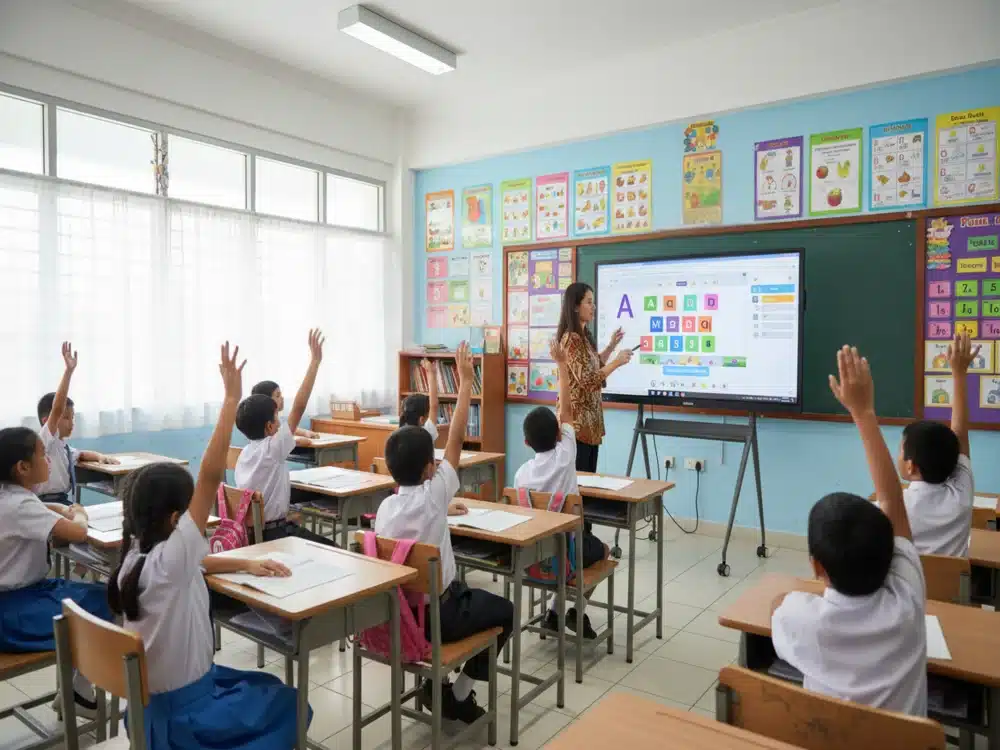In today’s digital era, traditional whiteboards and projectors are gradually being replaced by more innovative and interactive solutions. One such revolutionary tool is the interactive smartboard. Whether in classrooms, boardrooms, or training sessions, interactive smartboards are transforming the way people communicate, collaborate, and learn. But what exactly is an interactive smartboard, and why should businesses and educational institutions consider investing in one?
What is an Interactive Smartboard?
An interactive smartboard, also known as an interactive whiteboard, is a touch-sensitive display that enables users to write, draw, and interact with digital content using a stylus or even their fingers. Unlike conventional whiteboards, interactive smartboards integrate with computers, allowing users to access the internet, present multimedia content, and interact with applications in real-time. These boards are designed to be highly responsive, making them an excellent tool for boosting engagement in both educational and business settings.Key Features of Interactive Smartboards
- Touchscreen Interaction – Users can write, erase, and manipulate content with their hands or stylus, making lessons and presentations more engaging.
- Digital Annotation – Highlight, underline, or make notes directly on documents, PDFs, or presentations.
- Multimedia Integration – Display videos, animations, and interactive elements to enhance understanding.
- Wireless Connectivity – Connect to multiple devices wirelessly, eliminating cable clutter.
- Cloud Integration – Save and share files instantly using cloud storage services like Google Drive or OneDrive.
- Split-Screen Functionality – Enables multiple users to work on different parts of the board simultaneously.
- Remote Access – Teachers and presenters can control the board from their tablets or smartphones.
- High-Resolution Display – Most smartboards come with 4K resolution, providing a crisp and clear visual experience.
- Gesture Recognition – Supports multi-touch gestures like zooming, rotating, and panning, allowing a more intuitive experience.
- Collaboration Tools – Many smartboards come with pre-installed applications that promote collaboration through real-time document editing and sharing.
The Benefits of Using Interactive Smartboards
1. Enhanced Learning Experience
For educational institutions, interactive smartboards provide an immersive learning environment. Teachers can incorporate videos, quizzes, and interactive exercises to make learning more engaging. Students can collaborate, participate in problem-solving activities, and retain information more effectively. With access to real-time internet browsing, instructors can instantly pull up additional resources to enrich lessons.2. Increased Productivity in Meetings
In the corporate world, interactive smartboards streamline meetings by allowing real-time collaboration. Team members can brainstorm ideas, edit documents, and even conduct remote meetings with screen-sharing capabilities. Employees can present information in a more dynamic and interactive manner, enhancing the decision-making process.3. Saves Time and Resources
Unlike traditional whiteboards that require constant erasing and rewriting, interactive smartboards enable users to save, retrieve, and modify content instantly. This reduces the need for paper and markers, making it an environmentally friendly solution. Notes and drawings made during a meeting or class session can be saved and distributed to attendees afterward, eliminating the need for manual note-taking.4. Seamless Integration with Other Devices
Interactive smartboards connect seamlessly with laptops, tablets, and smartphones, allowing users to share and present content effortlessly. This makes it an ideal tool for business presentations, training sessions, and interactive workshops. Many smartboards also support screen mirroring, enabling multiple participants to share their screens simultaneously.5. Better Engagement and Collaboration
Whether in a classroom or a business setting, interactive smartboards foster engagement by allowing multiple users to interact with the screen simultaneously. This feature is particularly useful for group discussions, brainstorming sessions, and interactive training. In a learning environment, students can work on different problems at the same time, encouraging collaboration and teamwork.6. Improved Accessibility and Inclusivity
Interactive smartboards support various accessibility features, such as voice recognition, screen magnification, and text-to-speech functions, making them an inclusive tool for students and employees with disabilities. These features ensure that everyone can actively participate in learning and discussions, improving overall communication and comprehension.Choosing the Right Interactive Smartboard for Your Needs
Before purchasing an interactive smartboard, consider the following factors:- Screen Size – Choose a size that suits your space and audience.
- Touch Technology – Opt for multi-touch capabilities for a more interactive experience.
- Compatibility – Ensure it integrates well with your existing devices and software.
- Software Features – Look for pre-installed applications that enhance usability.
- Durability and Warranty – Check for warranty coverage and durability to ensure long-term use.
- Ease of Use – A user-friendly interface is crucial, especially in environments where multiple users will operate the board.
- Customer Support – Ensure that the brand you choose offers reliable technical support and training to maximize the board’s potential.
Industries That Benefit from Interactive Smartboards
Interactive smartboards are not limited to just schools and businesses; they have applications across various industries:- Healthcare – Used for medical training, patient education, and collaborative diagnostics.
- Retail – Enhances customer engagement by displaying interactive advertisements and product demonstrations.
- Government – Aids in strategic planning, presentations, and collaborative discussions.
- Manufacturing – Helps in design planning, quality control training, and process mapping.





